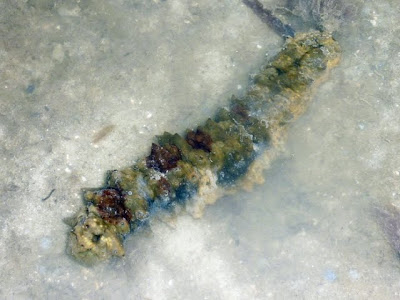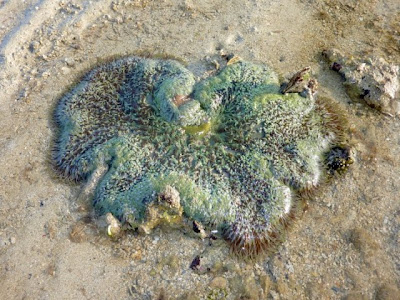Finally I get a chance to escape from work and stress this morning as I hit back on our lovely shores! This time to guide students at Semakau.
I woke up at 3am due to the noisy gusty winds outside and I thought, that's it! It will be yet another wet trip. Nevertheless, nothing stopped us from gathering at Marina South Pier at 5am to depart for Semakau. There were many participants today, from three schools!
Upon arrival at Semakau landfill begins our 2km walk along the road to the intertidal area. The gusty wind died down to a cool breeze and overlooking us is a glowy and warming sunrise. How sweet was the weather, thank God! In this photo is Wen Qing and her group of students.
And here is Chay Hoon with her group of students. I didn't realize a student was leaping in the air to pose for my inpromptu photo taking. Haha!
After braving the mosquito-infested forested trail, we reach the intertidal flats of Semakau. The lone Bakau here now has lots of seaweed entangled on its prop roots. We stopped for a while to discuss about mangroves in general, how they adapt to the adverse saline conditions and the different types of animals that one can find among the mangrove ecosystem.
We later neared the vast seagrass meadow that Semakau proudly houses and one of the special sea cucumbers we saw will be this Dragonfish sea cucumber (Stichopus horrens) which we rarely see on other Singapore shores.
Now introducing to you my group of the day: Stingray! I have the joy and honour to guide this promising group of NUS High students with Tammy (my assistant guide).
It was great to have them this morning as they were very cooperative, interested and asked good questions. In fact their trip is part of their Introduction to marine biology module and most students had a fair bit of prior knowledge about marine life. What is wonderful is that they get to visit Singapore's shores for their first time today!
After our group crossed the perpetual "long kang" or the death zone at the seagrass lagoon, more groups followed suit. The reason for having the death zone is to prevent trampling over the seagrasses.
One of the first animals we saw after crossing the death zone will be this juvenile Cushion star (Culcita novaeguinea). I love sea stars and am thrilled to see this lovely star. The students and I had a brief discussion on why the cushion star looks more like a ball than a sea star with long arms. Do you know why? :)
Along the sandy areas are many Common sea stars (Archaster typicus) performing pseudo-corpulation. At this position where the male interlocks the female below, both stars will release their eggs and sperms into the surroundings which will increase the chance of external fertilisation.
Also found along the way will be this bright greenish Giant carpet anemone (Stichodactyla gigantea).
The hunter seekers found a pair of Noble volute (Cymbiola nobilis). Their shells are very pretty don't you agree?
The sharp eyes of one of the participants found this not so common Black-lipped conch (Strombus urceus) which is listed as 'Vulnerable' on the Red List of threatened animals of Singapore.
What interests the students will be the conch's ability to move and flip itself using it's foot-like operculum. The ladies of the team were amazed with the two eye stalks of this small conch peering at them. Hehe!!
Another pretty snail found will be this recently-dead cowrie that is pinkish in colour. I have no idea what species this is.
The top star finds of the day must be the Knobbly sea stars (Protoreaster nodosus)! These huge stars never fail to tug the hearts of visitors to Semakau's lovely shores.
That's not all! The hunter seekers also later found yet another two Cushion star (Culcita novaeguinea). We were all star struck.... literally!
More organisms we saw for the day include the hairy crab, sandfish sea cucumber, stonefish sea cucumber, wriggly star anemone, colourful hard corals and also the flatworm! The students were excited to hear about penis fencing in flatworms.
If you are also interested in what happens during penis fencing, check out this video of mine!
On the way back, our wish to see a nudibranch was granted as I stumbled upon this pretty Lined chromodoris nudibranch (Chromodoris lineolata). It was found on a seaweed. As its species name (lineata) suggests, this nudibranch has lots of lines on its body.
We also flipped rocks to see what kind of life thrives underneath the rocks. It was fun to share the living shore of Semakau with students! We later proceeded with our landfill tour and a short debrief.
During the debrief, the students shared with each other about what they have learnt today as well as also telling Tammy and I that the trip far exceeded their expectation of Singapore's marine life. :)
That marks the end for our guiding regime at Semakau for this year. Looking forward to more of such trips when we resume the trips. :)
More photos of the day (full-sized) at my flickr page: http://www.flickr.com/photos/koksheng/archives/date-posted/2010/08/28/
Saturday, August 28, 2010
Semakau guiding with NUS High
Subscribe to:
Post Comments (Atom)



















.jpg)
4 comments:
are these students from the NUS high school sustainable development youth convention? I'm gonna be talking to them about biod conservation today! was planning to show them the wildsingapore sampler but think they saw much much more in person at semakau!! thx for sharing :)
Hi November, I'm not too sure. All
I know is that they took this Intro to Marine Bio module and they are from Year 3. :)
Cool to hear about the talk! Hope it will be a fruitful and engaging one!
its not a student jumping.. its actually mindy. hahahaha.
Really ah~! Haha! :)
Post a Comment